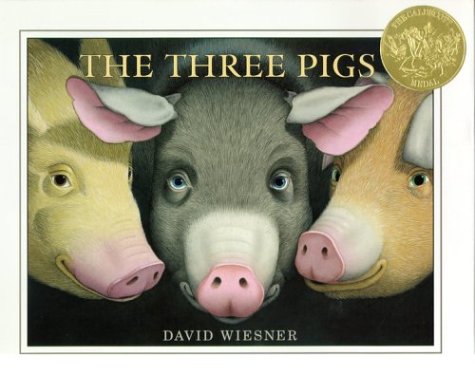 |
| https://d.gr-assets.com/books/1172092242l/138069.jpg |
Bibliography
Wiesner, David.
The Three Pigs. New York: Clarion Books, 2001. 0329279815
Summary
What starts out as a traditional telling of The Three Little Pigs quickly takes an
unexpected turn when the wolf unknowingly blows the first little pig completely
out of the story. The pig takes full advantage of this situation and quickly
finds his brothers, bringing them to safety and leaving the wolf in the story
frames, hungry and confused. The
pigs find that they are not limited to their own story and venture through a
number of different tales, collecting friends along the way.
Analysis
The Three Pigs
takes fractured fairy tales to a whole new level. Not just changing the viewpoint of the narrator or putting a
cultural spin on the story, this book challenges readers to think outside the
box, literally and figuratively.
Playing on his strengths as an illustrator, Wiesner seamlessly blends
small amounts of dialog with stunning illustrations. The pictures truly do steal the show and are capable of
telling the story in such a way that the dialog seems superfluous.
Young and old alike are able to enjoy this story. Younger readers enjoy the adventures of
the pigs; making and flying on paper airplanes, befriending a dragon and
running across familiar faces, such as the cat from Hey Diddle Diddle. Older
readers enjoy seeing the pigs transition from looking realistic to cartoonish
as they wander through the pages, finding illustrations from other Wiesner
books, and imagining the pigs tumbling through the world Wiesner has created
using story book pages.
When reading this book aloud to a second grade class, they
weren’t able to stay seated or simply listen. “Look at the pigs, they’re changing!” they would shout out
as the pigs moved from story to story.
The pages where the pigs were flying on the airplane were met with many
ooohs and ahhhhs. When one of the
pigs appeared to look out from the book and stated “I think…someone’s out
there,” he was met with a chorus of hellos and waves. They stated this was now one of their favorite books.
Awards and Reviews
*Caldecott Medal, 2001
“David Wiesner’s postmodern interpretation of this tale
plays imaginatively with traditional picture book and story conventions and
with readers’ expectations of both. (Though with Wiesner, we should know by now
to expect the unexpected.) Astute readers will notice the difference between
the cover’s realistic gouache portrait of the three pigs (who stare directly
out at the viewer with sentient expressions) and the simple outlined watercolor
artwork on the title page. In fact, the style of the illustrations and the way
the characters are rendered shifts back and forth a few times before the book
is done, as Wiesner explores the possibility of different realities within a
book’s pages. The text, set in a respectable serif typeface, begins by
following the familiar pattern—pigs build houses, wolf huffs and puffs, wolf
eats two pigs, etc. But while the text natters on obliviously, the pigs
actually step (or are huffed and puffed) out of the muted-color panel
illustrations without being eaten…Wiesner may not be the first to thumb his
nose at picture-book design rules and storytelling techniques, but he puts his
own distinct print on this ambitious endeavor. There are lots of teaching
opportunities to be mined here—or you can just dig into the creative
possibilities of unconventionality.” –K.F., The Horn Book
“Satisfying both as a story and as an exploration of the
nature of story, The Three Pigs takes visual narrative to a new level. Dialogue
balloons, text excerpts, and a wide variety of illustration styles guide the
reader through a dazzling fantasy universe to the surprising and happy ending.
Fans of Tuesday's Frog's and Sector 7's clouds will be
captivated by old friends the Three Pigs of nursery fame and their companions
in a new guise.” -Scholastic
Connections
Building a background from the few pages from the dragon’s
story seen in The Three Pigs,
students will write a continuation telling how the story would have gone, had
the pigs not stolen the dragon away.
Wiesner's Caldecott acceptance speech.
Students could write a letter asking the pigs to save a
character from another story and justifying why the character should be
saved.
In The Three Pigs,
the pigs made friends with the other characters they met. Write the names of other folktale
characters on slips of paper and put them into a basket. After students draw two names, they will
write a story or comic showing what happens when the characters met after being
pulled out of their stories.
No comments:
Post a Comment